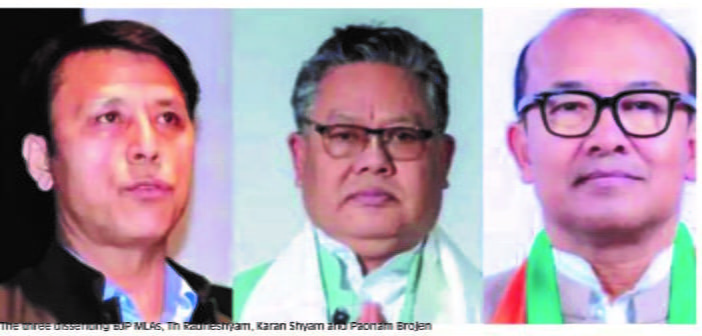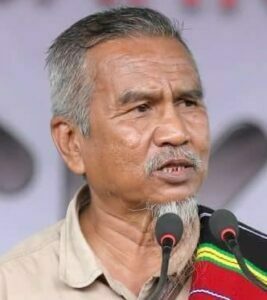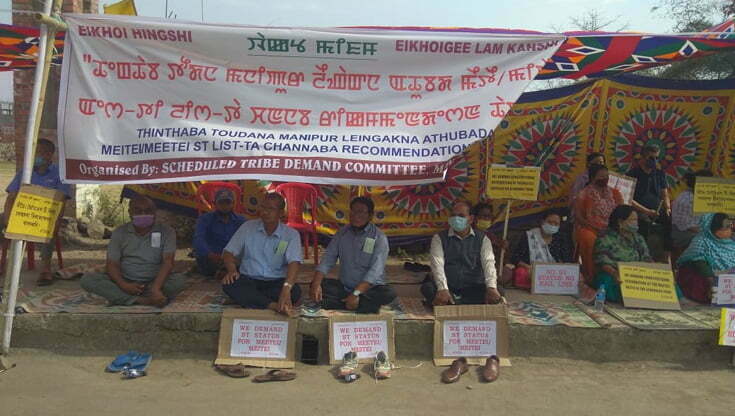
The BJP in Manipur had gathered more MLAs belonging to other parties to join ranks with them either by joining the party or lending support to the extent that the treasury bench today has 55 members sitting in it against the five in the opposition belonging to the Congress and as such the threat is not real.

By Yambem Laba
The movement for inclusion of the Meetei Tribe in the Scheduled List of tribes of India got a major fillip when the Manipur High Court gave a directive to the Manipur state government to give a response to the query from the Centre pending since 2013. The reply is to be given in one month’s time. The directive came after a petition by the Meetei Tribes Union, Manipur. It might be recalled that the Ministry of Tribal Affairs of the Government of India had sought the recommendation of the Manipur state government to enlist the Meitei in the ST List on 29 May 2013. In that letter, the Union Tribal Ministry had sought a report on the ethnographic and socio-economic survey of the Meitieis but had sat on it.
The Scheduled Demand Committee Manipur (STDCM), who had been in the forefront of the movement for the last 20 years or so, had welcomed the High Court’s directive which was arrived at by a single bench of the Manipur High Court of Acting Chief Justice M V Muralidharan. The STDCM had also garnered signatures of almost all the MLAs of the valley where the Meiteis reside. A Writ of Mandamus was filed by Mutum Churamani, secretary of the Meitei Tribes Union and seven others of the Union against the state of Manipur.
According to the petition, it was asserted that the Census carried by the Government of India since 2011 had been classifying Meeteis as a Tribe of the State and it was thus till Manipur’s merger with the Indian Union on 21 September 1949. Ajoy Pebam, the counsel for the petitioners, argued that the Meeteis lost the tribal tag after signing the Merger Agreement in 1949 and restoration of the status is imperative to preserve the ancestral land, traditions and culture. Various documentary references were annexed to the petition asserting that the Meeteis are still a tribe as per Articles 342(1) and 366(19), and 230(25) of the Indian Constitution and unfortunately, the Meeteis were left out while preparing the ST list under Article 342 of the Constitution, he added. He also added that the Chongthu, Khoibu and Mate tribes were classified as Scheduled Tribes of the Union as per an order of the Gauhati High Court dated 26 May 2003.
Appearing on behalf of the Government of India, the Deputy Solicitor General of India also conceded that the Meeteis lost their tribal status after the state’s merger with the Indian Union. The Court also observed that the Meitei Tribe Union had also submitted a representation to the Union Minister of Tribal Affairs on 18 April 2022 to include the Meeteis in the ST list and the Ministry had forwarded the same to Chief Secretary and again it was swept under the carpet. At this juncture, the counsel for the petitioners asserted that the continued silence of the successive state governments were tantamount to violation of the Right to Equality and Right to Life with Dignity which are enshrined under Articles 14 and 21 of the Constitution of India.
The Court also observed that the state had not given any satisfactory explanation for not submitting the recommendations which the Centre has been seeking for the last 10 years.
Apart from the STDCM and the Meitei Tribe Union, the World Meitei Council and the Kangleipak Kanba Lup (KKL) had been vociferously demanding for the inclusion of the Meeteis in the ST List. The KKL had gone one step further and asked Union Home Minister Amit Shah to decide on the ST Status of the Meeteis before signing the final accord with the rebel Nagas viz the NSCN(I-M) and others.
It should also be on record that whilst the Constitution was being prepared, the then Constituent Assembly of India had deputed the late Gopinath Bordoloi of Assam and Stanley Nicholas Roy of the then Khasi and Jaintia Hills (now Meghalaya) to Manipur to seek the views of the Meeteis on the question of being included in the ST list. They, however, did not meet the public, but had just met three personalities, two Meitei Brahmins amongst them. They were Dwijamani Dev Sharma, Krishna Mohan Singh and another one, who were fanatical Hindus. They asserted that the Hindus, who are the descendants of the Aryans, be classified as Tribals. This is how the Meeteis had missed the bus in 1950 when India adopted the Constitution.
However, it needs to be pointed out that the then RK Ranbir government in 1991 had imposed prohibition in Manipur following a ban on sale of liquor in Manipur by the proscribed People’s Liberation Army (PLA) of Manipur. Likewise, the reluctance of the successive governments of Manipur, beginning from 2013 till now, must have been reluctant to forward the recommendation of the inclusion of the Meeteis in the ST list because of the opposition of the outlawed and oldest insurgent group in Manipur, the United National Liberation Front (UNLF), had been against the idea of the Meeteis being classified as a Scheduled Tribe. They first launched their tirade through their Students and Civil Society Organisations who are their fronts in the public.
Five years ago, I was summoned to the CHQ of the UNLF in Myanmar as I had been quite vocal and had written in favour of the demand of the STDCM. I was asked to explain my position on it. When asked as to whether they had openly declared their stance against it, the reply was “No”. Then the issue was settled – if one can assume that statements issued by their fronts can be assumed to be that of the UNLF. Then my interrogators remained silent. Two years later, the UNLF in their annual statement announced the UNLF’s stance against the demand of the Meeties of being classified as a Scheduled Tribe as it negates the existence of Manipur, particularly the Meeteis’ 2000 years of existence as a nation state and civilisation. The suzerainty of the Meitei Kings had once upon a time spanned from the banks of the Chindwin in Myanmar to that of the Surma in present day Bangladesh. But after joining India, the Meeteis are now confined to a mere 9 per cent of the state’s total geographical area. Their future is bleak as they cannot settle down in the remaining 90 per cent of the state’s area which are scheduled tribal lands belonging to the various scheduled tribes of Manipur while the reverse is not true. However, the question is, if the Biren Government is not afraid to defy the PLAs diktat of prohibition and had recently lifted prohibition from Manipur, why it is afraid to stand against the UNLF stance against the ST tag for the Meeteis. But now with the directive from the High Court, the reply might be coming shortly.
CHINKS IN CM BIREN’S ARMOUR
While pondering over the High Court’s directive, the Biren Ministry received a jolt. It began with former minister and now MLA from the Heirok Assembly Constituency and Advisor to the Chief Minister Th Radheshyam resigning from his post, citing lack of any responsibility being given to him. He said he did not know how to answer the questions raised by his supporters when they urged him to take up an issue with the CM. He also said that while the CM was talking about environmental protection, his own younger brother was allegedly involved in timber trade. His move was followed by former minister and MLA from Langthabal Assembly Constituency and Chairman of the Manipur Tourism Corporation Karam Shyam Singh, who also resigned from his post.
He also cited not being not only being given any responsibilities and power, and of being humiliated publicly on numerous occasions by the Chief Minister. Then the third to throw in his towel was Paonam Brojen from Wangjing Assembly Constituency and was holding the post of Chairman of the Manipur Development Society (MDS). He went public as to how the Chief Minister had dumped him after, upon his advice, his workers were made to engage in road constructions in his constituency. Then suddenly, he was informed that the work orders for the already constructed works had been cancelled. His workers, having expended about Rs 6 crore in the process, are now fuming and Brojen now says that he is not able to stay at his home as he cannot face his workers and give them an explanation.
According to sources, there are about 15 BJP MLAs reportedly camping in Delhi demanding the replacement of N Biren Singh as the Chief Minister. Although the BJP returned 32 in the House of 60 at the last hustings, only six MLAs out of the 32 when Biren Singh was elected as the leader of the BJP Legislative Party last year. BJP Big-wig Sambit Patra had orchestrated the drama and he had reportedly/allegedly asked Govindas Konthoujam, who had joined the BJP after having resigned as the President of the Congress in Manipur, on the eve of the elections last year to propose Biren Singh’s name as the leader. Then another tribal MLA seconded the proposal and he became Chief Minister.
The BJP on the other hand had gathered more MLAs belonging to other parties to join ranks with them either by joining the BJP or lending support to the extent that the treasury bench today has 55 members sitting in it against the five in the opposition belonging to the Congress and as such the threat is not real. But the fact remains that dissent within the Party has already surfaced against the Chief Minister and it is a point to be noted.
ARMY VERSUS POLICE
In the meantime, one Manipuri army officer Major Thokchom Bhagatjit Singh belonging to 2nd Madras Regiment had posted on social media remarks critical of Chief Minister N Biren Singh. His elders back home, aware of the sensitivity of CM Biren on social media posts, had advised him to delete his post. CM Biren had earlier slapped the National Security Act on numerous occasions for such posts criticising him or his government directly or indirectly. So the young Major deleted the post from the account which was opened under another name and he returned home on leave. That was when the Sekmai Police of the Imphal West District came and picked him upon intimation from the Cyber Crime unit of the Manipur Police. This arrest was made properly as an arrest memo was issued and an FIR registered and he was produced before the Magistrate 24 hours after he was taken into custody. This was on 13 April, earlier this month. Then on the same day, one Md. Aksar Ali, president of the BJP’s Minority Morcha, filed another complaint against the Major at the Porompat Police Station in Imphal East. He was again arrested, but this time no arrest memos were issued and no FIR was lodged, yet he was kept in the lockup for 18 hours. That was when the army stepped in and they came to the Porompat Police Station and told the police that they can arrest an army man on charges of rape, murder or culpable homicide not amounting to murder, and not for any charges including posts on social media. The police then made a hasty retreat. The officer may be facing a court of inquiry from his commanding officer but not from the police or civil court.
The CM apparently has an army of cyber warriors who will troll anyone posting against him or the government on social media. But this time it had bitten off more than it could chew, it seems.
(The writer is a senior journalist at The Statesman. This article was first published by The Statesman. All opinions expressed here are the writer’s own and do not represent the views of TFM)
The post Demand for ST status, Chinks in Biren’s armour and Army vs Police first appeared on The Frontier Manipur.
Read more / Original news source: https://thefrontiermanipur.com/demand-for-st-status-chinks-in-birens-armour-and-army-vs-police/


